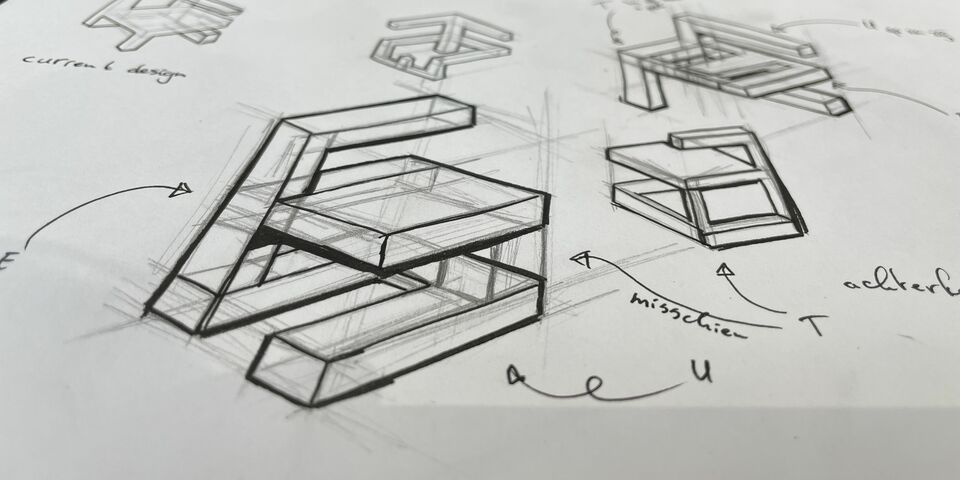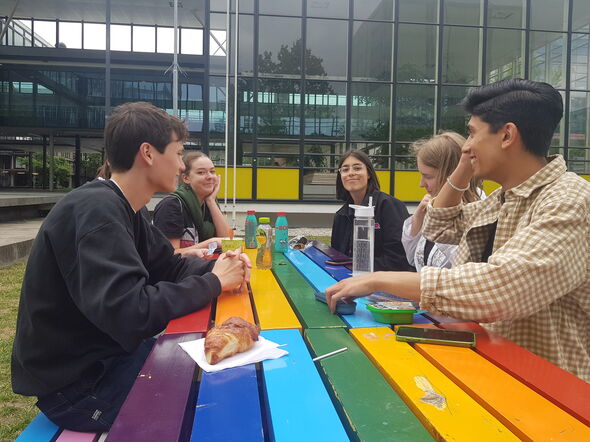A sustainable reminder at the conference table
With the aim of giving ‘a sustainable future’ a physical place at the decision-making tables, students are currently in the process of designing the Chair of the Future, in collaboration with the GO Green Office. By giving the chair a prominent place in important meetings at TU/e, the initiators hope that sustainability considerations will be structurally included in decision-making processes. The design team will present the chair during the opening of the new academic year on September 4.
“A few months ago, we stumbled upon a news article about Rik Thijs, the Eindhoven alderman for climate and energy, who had received a “future chair” from GroenLinks,” says Koen de Nooij, master’s student in Mathematics & Computer Science and Strategic Manager of the Go Green Office. “It was a simple cardboard chair, but it symbolized the future at the conference table, and we liked that idea.”
Different materials
The idea of using a chair to call attention to a sustainable future in decision-making at the university inspired the initiators to launch the Chair of the Future project. Over the past few months, the design team has been working hard to design a chair (see one of the sketches in the main photo) that is supposed to symbolize the three important aspects - economic, ecological and social sustainability - through the use of different materials.
“These have to be balanced in order to carry the future together,” says Margot Beekhuizen, master’s student in Industrial Design and a member of the design team. “We’re looking for materials associated with these aspects. For example, for social sustainability we were thinking about mycelium, a network of fungal threads that covers the entire earth, symbolizing healthy social connectedness.” In addition to its symbolic value, this material is also in line with the design team's commitment to using only circular materials.
The chair, which is currently being worked on in collaboration with innovation Space, will be presented during the opening ceremony on September 4 and given to the President of the Executive Board Robert-Jan Smits. It is not yet certain what will happen to the chair in the long term, but if it were up to the team, it would be given a prominent place at the university and would be included in important meetings and gatherings at TU/e in order to call for consideration of sustainability aspects when making important decisions. “That’s why we make sure during the design process that it can be taken apart or that it’s not too heavy,” Beekhuizen says.
Ambassador
The design team also had two meetings with Board President Robert-Jan Smits to get him on board with the project. “He was excited and shared his thoughts with us from the very beginning, so it was really nice that he was so supportive of us,” says Beekhuizen. “He also immediately agreed with us that once the chair is awarded, it shouldn’t be left discarded somewhere. It should be given a proper display.” “We hope Smits will become our ambassador,” De Nooij adds. For him, the chair also serves as a tool to bring the entire university on board with the sustainability transition.”
In addition to this chair, the team wants to create small scale models and give them to department boards. “That will also provide an opportunity to talk about a sustainable future and what the goals are in that regard,” De Nooij explains. Of course, you won’t be able to sit on these little chairs, unlike the one real chair. But that doesn’t matter because the whole idea is to keep the chair empty during meetings. “The chair is supposed to represent the future, so the point is to not have anyone sit in it,” he explains.
Statement
“Because we want to show that the whole university cares, we are trying to get everyone in our TU/e community on board,” he continues. The team has asked all study, student, sports and culture associations to sign a statement in which they clearly explain their message. Since then, over 40 organizations and over 70 individual students and staff have already signed in support of the initiative.
“For us, the most important thing is to use the chair to reach everyone at the university,” De Nooij stresses. “There are a great many levels and different departments, but we want to tell everyone: you too have to take steps in order to give more consideration to that sustainable future, whether you’re a researcher, a member of the teaching staff or manage operations on campus.”
Would you like to support the initiative? To do so, visit the project’s website. Do you have questions or want to contribute to the project? Feel free to send the initiators a message. Follow the project’s Instagram account for updates.



Discussion